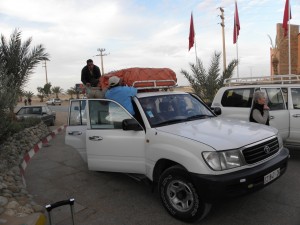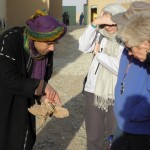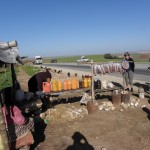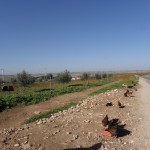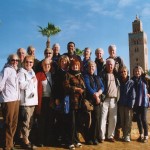Up early in Erfoud, we loaded our gear onto our assigned four-wheel drive vehicles. We were split into groups of four fellow travelers assigned to the same shephard driver for the next few days. Erfoud is an enormous military town but the surrounding region specializes in unique marble and granite whose rare distinction is enormous embedded fossils. So the days stops included a fossil marble works, a school established about 2 years ago for nomadic children, a camel ride and then checking out and settling in to our camp site.
Fossil Finds at Edge of the Sahara
- Learning to See
- Fossils to Kitsch
- Turning Out the Tchotchke
- Fossils Galore
- Archeological Rigor
- Showroom Bargains
An early Mid-December morning and we were clambering over huge stacks of fossis embedded in marble learning about what these resourceful craftsmen could make to both sell to tourists and market abroad. What a pitchman!! Handsome, charming a notice his American levis peeking out from under his native costume.
Overland to Volubilis
An early departure put us on the road to Fez. Stops and discoveries along the journey began unfolding the daily life of the majority of Moroccans allowing us to appreciate the present as it is still dramatically shaped by their fascinating history.
We meandered along and over the local by-ways through rich rolling farmland, olive groves and vineyards. Most of this verdant land is dependent entirely upon rainfall and the waterways descending from the Rif and Middle Atlas. Land is divided into small family farms or groves, Villagers grow wheat, barley, citrus and cotton in a mild climate a lot like Southern California Migrant workers live on government lands and move around as the seasons change supplementing their income with what they can produce and sell along the roadside. It was the end of olive season and but we saw men and women working together to finalize the last harvesting.
Lunch in Meknes, heart of a vibrant wine growing area, a city divided into ancient and modern. The old part is on the west bank of the river Oued Boukfrane with the new town on the east. Pictured below is the Bab el-Mansour, the main gate leading into the medina proceeding through a ring of battlements. Described as far less touristy than Marrakesh or Fez, there are still abundant souks selling carpets and handicrafts but the local tradesmen and service people are there primarily for the locals.
Volubilis, the day’s highpoint, suddenly came in view as we swung around a valley and passed through the groves and family farms at the outskirts of Moulay Idriss, a vibrant small town. The Triumphal Arch signals the site and is visible from the approach. Ruins largely date from the 2nd and 3rd centuries AD but excavations reveal that the original settlement was by Carthaginian traders in the 3rd century BC.
Rabat Reconnoitering
Touchdown Casablanca but off to Rabat
All legs of our flight into Casablanca were smooth.
Casablanca is Morocco’s largest city, its chief port and vibrant center of commerce. It’s also the biggest city in the Maghreb–the name for the collective five North African countries, Algeria, Morocco, Tunisia, Libya, and Mauritania as well as the disputed territory of the Western Sahara. The word Maghreb literally means “place of sunset or “the west” (from an Arabian perspective). Now it is primarily used by Arabs to referring collectively to these five countries.
As it turned out we also arrived about sunset. We joined our tired fellow travelers, some of whom we had met in Paris at the Air-France gate and were all welcomed by our guide Abdal who was there to greet us. We efficiently boarded our bus and were whisked off in the gathering dusk to Rabat along the major Casablanca highway clogged with commuters. Sights to see had to wait until the next day.
